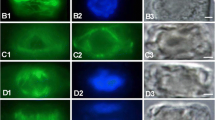Summary
Ultrastructural abnormalities of various kinds and severity appeared inEuglena gracilis green cells after a 48-hour exposure to 4 × 10−4M of isoprophyl-N-phenylcarbamate (IPC), a widely used herbicide thought to affect microtubules and/or microtubule organizing centers in susceptible plant and animal species.
A high proportion of cells contained nuclei in the G 2 phase of the cycle; in a significant percentage of organisms, however, structural aberrations of the nucleolus and chromosomes were evident. The pellicle outline, chloroplasts, mitochondria, and dictyosomes were also affected. The cytoplasm was rich in dense bodies which sometimes showed granular, fibrillar or tubular materials. Furthermore IPC partially inhibited flagellum regeneration after mechanical amputation.
The mechanism by which IPC causes these responses remains unclear. Nevertheless, some indications suggest that the herbicide acts primarily on microtubule organizing centers. However, mitochondria, chloroplasts and nuclear constituents appear as possible additional targets of the compound.
Similar content being viewed by others
References
Bertaux, O., Frayssinet, C., Valencia, R., 1976: Evolution ultrastructural du noyau et de nucléole deEuglena gracilis Z. au course du cycle cellulaire. C. R. Acad. Sci. Ser. D282, 1293–1296.
Dippell, R. V., 1976: Effects of nuclease and protease digestion on the ultrastructure ofParamecium basal bodies. J. Cell Biol.69, 622–637.
Dodge, A. D., 1975: Some mechanisms of herbicide action. Sci. Prog. Oxf.62, 447–466.
Dustin, P., 1978: Microtubules. Berlin-Heidelberg-New York: Springer.
Gillott, M. A., Triemer, R. E., 1978: The ultrastructure of cell division inEuglena gracilis. J. Cell Sci.31, 25–35.
Hepler, K. H., Palevitz, B. A., 1974: Microtubules and microfilaments. Annu. Rev. Plant Physiol.25, 309–362.
Hickey, E. L., Coffey, M. D., 1978: A cytochemical investigation of the host-parasite interface inPisum sativum infected by the downy mildew fungusPeronospora pisi. Protoplasma97, 201–220.
Hofmann, C., Bouck, B., 1976: Immunological and structural evidence for patterned intussusceptive surface growth in a unicellular organism. J. Cell Biol.69, 693–715.
Magistrini, M., Szöllösi, D., 1980: Effects of cold and isopropyl-N-phenylcarbamate on the second meiotic spindle of mouse oocytes. Eur. J. Cell Biol.22, 699–707.
Marcenko, E., 1980: Effect of isopropyl-N-phenylcarbamate onEuglena. Acta Bot. Croat.39, 71–78.
Mollenhauer, H. H., 1974: Distribution of microtubules in the Golgi apparatus ofEuglena gracilis. J. Cell Sci.15, 89–97.
Moreland, D. E., 1967: Mechanisms of action of herbicides. Annu. Rev. Plant Physiol.18, 365–386.
Moyne, G., Bertaux, O., Puvion, E., 1975: The nucleus ofEuglena. I. An ultracytochemical study of the nucleic acids and nucleoproteins of synchronizedEuglena gracilis Z. J. Ultrastruct. Res.52, 362–376.
Oliver, J. M., Krawiec, J. A., Berlin, R. D., 1978: A carbamate herbicide causes microtubule and microfilament disruption and nuclear fragmentation in fibroblasts. Exp. Cell Res.116, 229–237.
Rosenbaum, J. L., Child, F. M., 1967: Flagellar regeneration in protozoan flagellates. J. Cell Biol.34, 345–364.
Thiéry, J., 1967: Mise en évidence des polysaccharides sur coupes fines en microscopie électronique. J. Microsc.6, 987–1019.
Vannini, G. L., Fasulo, M. P., Bruni, A., Dall'Olio, G., 1978: Structural and developmental aspects during the greening process ofEuglena gracilis treated with myomycin. Protoplasma96, 335–349.
Vannini, G. L., Fasulo, M. P., Mares, D., 1980: Physiological and ultrastructural changes inEuglena gracilis in response to a carbamate herbicide. Caryologia33, 139–140.
Weisenberg, R. C., 1972: Changes in the organization of tubulin during meiosis in the eggs of the surfclam,Spisula solidissima. J. Cell Biol.54, 266–278.
Author information
Authors and Affiliations
Additional information
The study was supported by a grant from Italian Research Council (CNR), contract No. 80.00420.04.
Rights and permissions
About this article
Cite this article
Vannini, G.L., Mares, D. & Dall'Olio, G. Structural alterations inEuglena gracilis exposed to the herbicide isopropyl-N-phenylcarbamate (IPC). Protoplasma 111, 189–194 (1982). https://doi.org/10.1007/BF01281966
Received:
Accepted:
Issue Date:
DOI: https://doi.org/10.1007/BF01281966




